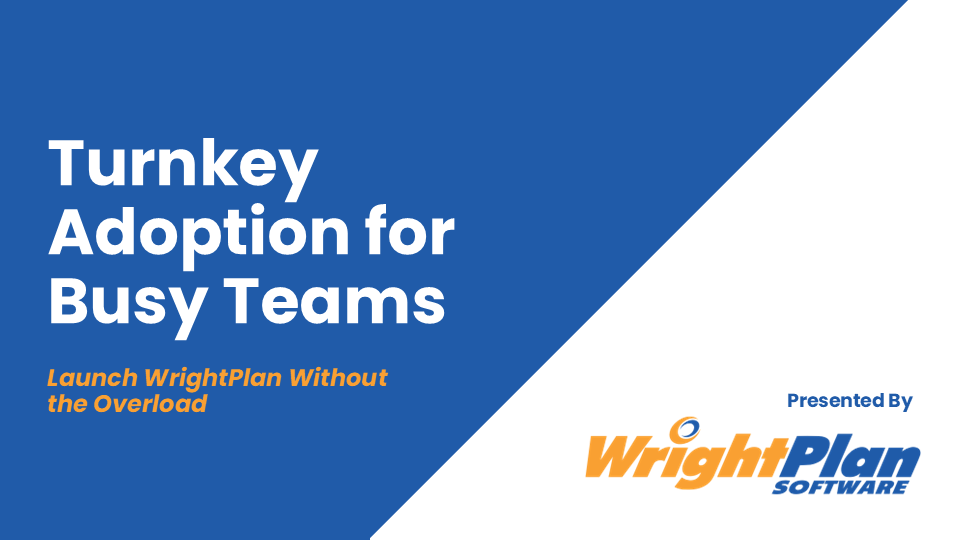The 5 Most Common Objections to Tech Adoption (And How to Overcome Them)
Meet resistance with flexibility, clarity, and long-term support
Adopting new technology can feel like one more thing your team doesn’t have time for. If you’ve ever tried to roll out a new system and hit a wall—whether from bandwidth, buy-in, or bad timing—you’re not alone.
At WrightPlan, we’ve helped dozens of companies in crane, rigging, millwright, and machinery moving overcome those barriers and successfully modernize. In this post, we’re breaking down the five most common objections to tech adoption—and how to beat them.
In this post, you’ll learn:
Why tech adoption stalls—and how to keep things moving
How to train and implement without overwhelming your team
What it takes to launch successfully and make it stick
Objection 1: “We Don’t Have Time”
Let’s be honest: most teams are running lean. Taking on a new system can feel like just another project you don’t have capacity for.
But here’s the reality: sticking with spreadsheets, paper, and disconnected systems can cost you 15+ weeks of lost productivity every year.
When time is tight, improving efficiency becomes even more critical—not less.
How to overcome it:
Choose a turnkey implementation so our team does the heavy lifting
Use a phased rollout to keep things manageable
Leverage your sandbox environment to test and learn safely
Keep weekly check-ins short and efficient (most are 15–60 minutes)
Objection 2: “Our Team Isn’t Tech-Savvy”
Even the most reliable crews can get anxious when faced with a new system. For teams used to whiteboards, paper tickets, or legacy tools, “new software” can sound like code for frustration and confusion.
But avoiding technology leads to bigger headaches—like communication breakdowns and lost paperwork.
WrightPlan makes adoption approachable with simple tools and training that meet your team where they are.
How to overcome it:
Start with a train-the-trainer model so internal champions can lead the way
Offer hands-on sandbox training without the pressure of going live
Use step-by-step videos, help articles, and on-demand learning paths
Tailor training delivery: onsite, remote, or hybrid—whatever works for you
Objection 3: “We Can’t Afford the Disruption”
If you’ve got active jobs on the go, the idea of switching systems midstream can feel like asking for chaos. Even if you know you need to upgrade, the fear of disruption—missed jobs, confused staff, or billing delays—can stall progress.
But delaying change guarantees you’ll still be working around the same limitations months down the road.
WrightPlan’s phased rollout helps you adopt gradually, without derailing your day-to-day.
How to overcome it:
Use a phased go-live strategy: one module at a time
Define a clear cutover date to avoid running two systems in parallel
Ensure consistency with the same team from implementation to support
Rely on ongoing check-ins and post-launch guidance
Objection 4: “The System Won’t Fit Our Process”
No one wants to overhaul their operations just to fit into someone else’s software box. If your team has dialed-in processes, it’s natural to worry that new tools will force unnecessary changes.
What works for one company might not work for another—and a rigid system won’t flex when your needs evolve.
WrightPlan is designed to adapt, starting with your existing workflows and tailoring the system to fit how you already operate.
How to overcome it:
Work with WrightPlan’s implementation team to configure the system around your workflow
Decide what makes sense for your rollout—quoting-first, dispatch-first, or something else
Use guided templates for data imports and integrations
Build flexibility into every stage of implementation
Objection 5: “We’ve Tried Before—and It Didn’t Stick”
Many companies come to us after a failed software rollout. Maybe the system was too complex, training fell short, or early momentum faded.
Whatever the reason, it leaves teams understandably cautious about trying again.
WrightPlan focuses on long-term adoption, with ongoing support and empowered admin training that makes sure your investment lasts.
How to overcome it:
Assign a dedicated project champion to drive adoption
Combine personalized admin training with repeatable documentation
Rely on a smooth handoff from implementation to support
Keep momentum with live webinars, release notes, and feedback loops
What Sets Successful Rollouts Apart?
Here are a few best practices we see in high-performing implementations:
Appoint an internal champion early
Be open to evolving your current processes
Balance speed with team readiness
Invest in both live and self-paced training
Define a clear cutover point—and stick to it
Build long-term ownership within your admin team
Ready to Move Past the Roadblocks?
If you’re thinking about upgrading your operations—but stuck on the “how”—our team is here to help.
Book your free Workflow Analysis and we’ll walk through your current processes to show you how WrightPlan can streamline your rollout—on your timeline.


